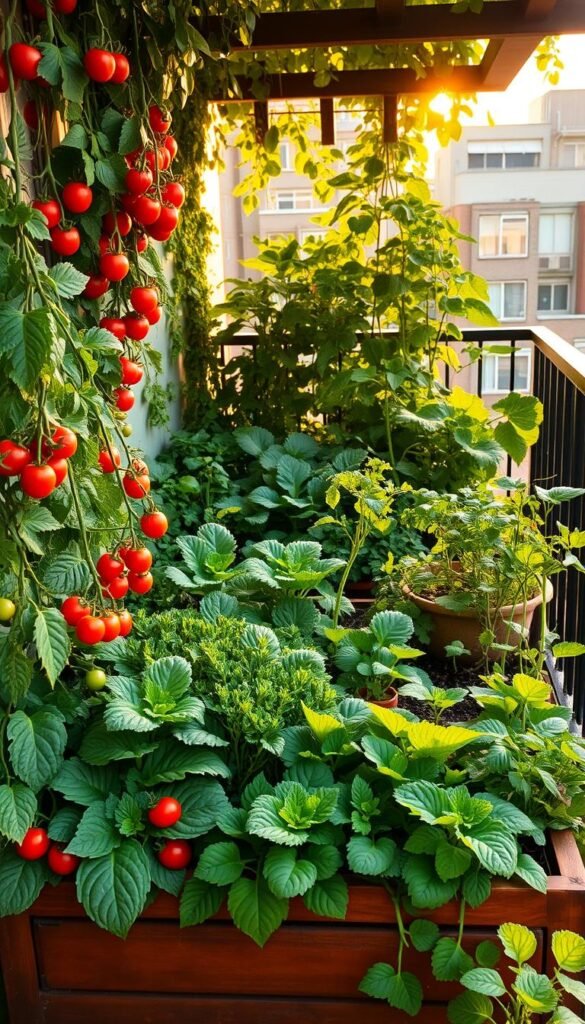You don’t need a sprawling backyard to enjoy homegrown veggies. Even the tiniest balcony can become a thriving garden with the right approach. All it takes is sunlight, creativity, and a few smart choices to turn limited space into a green oasis.
Container gardening makes it easy to grow fresh flavors at home. Unlike traditional plots, pots let you control soil quality and move plants to catch sunlight. Managing pests becomes simpler, too—since your vegetables aren’t rooted in the ground, you can address issues quickly.
This guide focuses on five fast-growing, space-friendly options perfect for tight areas. You’ll learn which varieties thrive in pots and how to set up your balcony for success. We’ll also share tips on choosing containers, arranging plants, and maximizing every inch.
Ready to start? Let’s transform your outdoor area into a productive, pint-sized paradise—one leafy harvest at a time.
Getting Started with Balcony Container Gardening
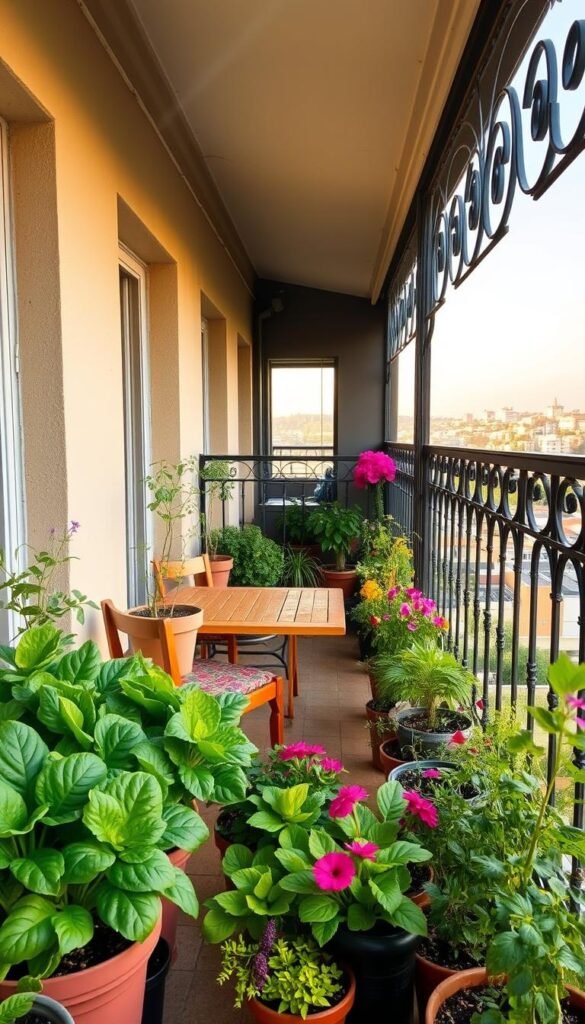
Transforming your balcony into a lush edible paradise is simpler than you think. The secret? Container gardening—a flexible method that turns cramped corners into productive plots. Whether you’re working with a few square feet or a narrow ledge, this approach lets you grow fresh flavors without sacrificing style.
Why Pots Beat Traditional Plots
Limited space becomes an advantage with containers. You decide the soil mix, shuffle plants to chase sunlight, and spot pests before they spread. No digging, no weeds—just quick adjustments to keep your greens thriving.
Sunlight Is Your Best Friend
Most vegetables need 6-8 hours of direct light daily. Observe your balcony for a few days: south-facing spots often work best. No full sun? Leafy greens like spinach adapt well to partial shade.
Start with 2-3 easy crops in lightweight pots. As confidence grows, add hanging planters or stackable boxes. Remember—every tomato snipped from your urban oasis tastes sweeter because you grew it.
Essential Tools, Containers, and Soil Tips
The right gear turns your balcony into a productive space. Start with lightweight tools like a watering can with a narrow spout and gloves to protect your hands. Pruners, a trowel, and a hand rake simplify daily tasks—no bulky equipment needed. But your containers and soil are the real foundation. Get these right, and your plants will reward you with vigorous growth.
Selecting Containers with Proper Drainage
Drainage holes are non-negotiable. Without them, water pools at the bottom, drowning roots. Look for pots with multiple holes or drill your own. Material matters, too: plastic retains moisture longer, while terra cotta breathes better for herbs like thyme.
Match container size to your crop. Shallow-rooted lettuce thrives in 6-inch-deep boxes, but tomatoes need 12-18 inches. Always leave room for roots to spread—cramped plants struggle to absorb nutrients.
Opting for the Right Potting Soil
Skip heavy garden dirt—it compacts in containers, choking roots. Instead, choose a fluffy potting mix labeled for container use. These blends often include perlite for airflow and slow-release fertilizer to feed plants for weeks.
Refresh soil each season. Over time, organic matter breaks down, leaving less room for water and oxygen. A yearly refresh keeps your garden thriving without guesswork.
Top 5 Compact Vegetables for Small Balconies
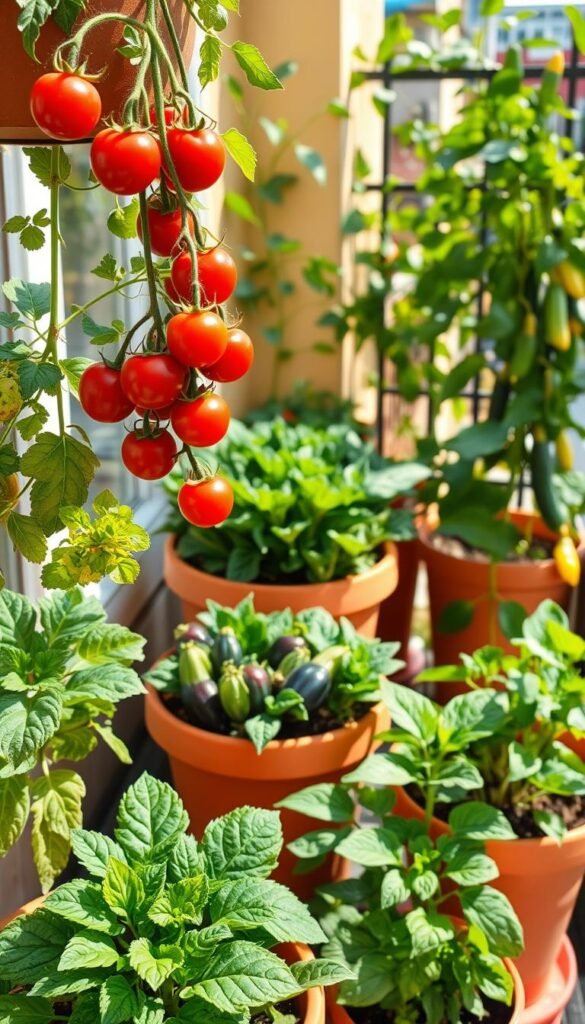
Urban gardeners know big flavor doesn’t require acres of space. These five vegetables thrive in containers, offering quick harvests and vibrant colors. Let’s explore varieties that turn railings and windowsills into productive plots.
Cherry Tomatoes, Peppers, and Cucumbers
Sweet orange cherry tomatoes burst with flavor in 12-inch pots. Their trailing vines climb trellises, saving floor space. Pair them with dwarf jalapeño peppers—spicy gems that produce all summer.
Try Spacemaster cucumbers, bred for tight spots. Their 3-foot vines yield crunchy snacks without sprawling. Use self-watering pots to maintain consistent moisture for these thirsty climbers.
| Vegetable | Container Size | Harvest Time | Key Benefit |
|---|---|---|---|
| Cherry Tomatoes | 12-14″ deep | 60 days | Continuous yield |
| Peppers | 10-12″ wide | 70-90 days | Heat-tolerant |
| Cucumbers | 5-gallon bucket | 55 days | Compact vines |
Radishes, Lettuce, and Other Leafy Greens
Sparkler radishes mature in 25 days—perfect for impatient growers. Sow seeds every two weeks for nonstop crunchy bites. Butterhead lettuce grows lush in shallow trays, ready to trim in 30 days.
Mix in spinach and arugula for peppery salads. These greens handle partial shade, letting you use less sunny corners. Rotate crops every 3 weeks for endless leafy harvests.
Creative Space-Saving Planting Techniques

Your balcony’s potential isn’t measured in square feet—it’s about how cleverly you use every inch. By reimagining layouts and container setups, you can cultivate a lush mix of vegetables herbs while keeping walkways clear. The trick lies in combining practicality with visual flair.
Stack, Hang, and Layer
Turn walls and railings into edible art galleries. Try these ideas:
- Suspend strawberry planters from overhead beams
- Mount old rain gutters along railings for shallow-rooted lettuces
- Stack wooden crates to create a pyramid of basil and dwarf peppers
Staggering container heights adds depth and variety. Place tall pots of rosemary behind low-growing thyme, letting textures contrast. A vertical pallet garden lets you grow upward—attach small pots or fabric pockets for herbs like mint and parsley.
Mix edible and ornamental flowers for bursts of color. Marigolds repel pests while nasturtiums add peppery flavor to salads. Even a repurposed shoe organizer can host radishes and microgreens in its pockets.
Experiment with arrangements weekly. Rotate pots to balance sunlight exposure, or cluster moisture-loving plants like cilantro near self-watering systems. With each creative tweak, your grow balcony becomes more productive—and uniquely yours.
Balcony Garden Maintenance and Nutrient Management
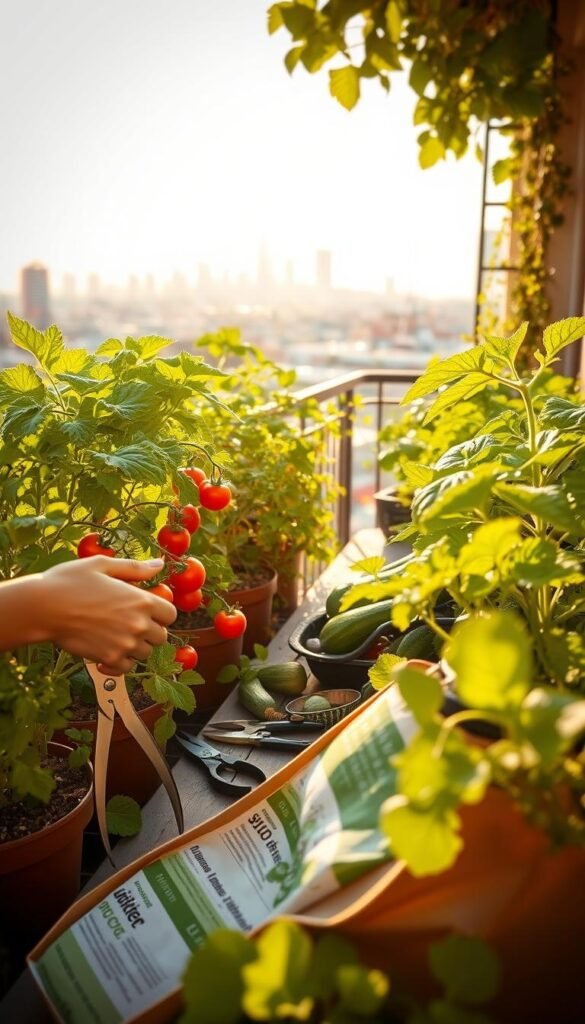
Keeping your green haven thriving requires simple daily habits and seasonal tweaks. A little attention goes a long way in ensuring leafy harvests and vibrant flavors right from your patio.
Watering and Fertilizing Best Practices
Check soil moisture daily by sticking your finger an inch deep. Plants in containers dry faster than ground soil—water when the top layer feels crumbly. Morning watering reduces evaporation and prevents overnight mildew.
Feed your garden every 2-3 weeks with organic options like bone meal or compost tea. These release nutrients slowly, preventing root burn. In peak summer, increase feeding frequency for heavy producers like tomatoes.
| Task | Frequency | Tools/Materials | Key Benefit |
|---|---|---|---|
| Watering | Daily checks | Watering can with narrow spout | Prevents drought stress |
| Fertilizing | Every 14-21 days | Liquid seaweed or chicken manure pellets | Boosts fruit production |
| Soil refresh | Each planting cycle | New potting mix + perlite | Improves root health |
Pest Control and Seasonal Adjustments
Spot aphids early by inspecting leaf undersides weekly. Blast them off with water or apply diluted castile soap spray. Grow marigolds between crops to deter beetles naturally.
As seasons shift, adjust care routines. In fall, protect tender greens like baby spinach with row covers. Rotate crops every 3 months to keep soil lively—replace spent summer plants with cool-weather kale or Swiss chard.
Planning Your Garden for Every Season
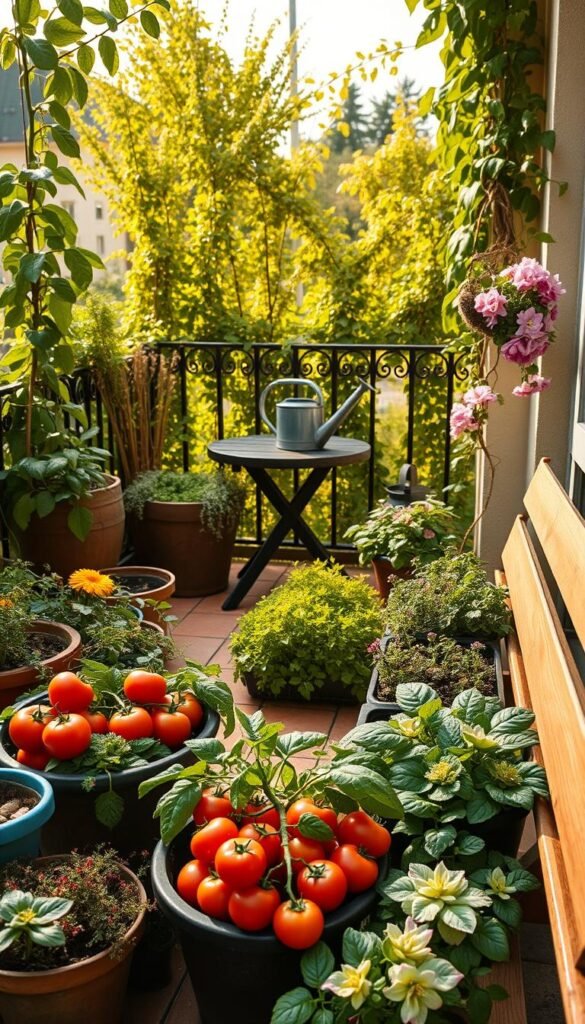
Your balcony’s growing potential changes with the sun’s angle and temperature shifts. By tailoring your plant choices to these rhythms, you’ll enjoy fresh harvests year-round. Start by mapping sunlight patterns: track which areas get 6+ hours of direct light (full sun) versus spots with dappled shade.
Match Plants to Your Light Conditions
Sun-loving tomatoes and carrots thrive in bright zones. Choose determinate tomato varieties like ‘Patio Princess’ that stay compact. For shady corners, plant leafy greens or rosemary—this herb tolerates partial light while repelling pests.
Rotate crops every 3-4 months. Swap summer beans for fall carrots, using the same containers. Cooler seasons let you grow crisp onions and frost-tolerant spinach. Mix quick-growing seeds like radishes with slower plants to maximize yields.
| Crop | Sun Needs | Best Season |
|---|---|---|
| Tomatoes | Full sun | Summer |
| Carrots | Partial shade | Fall/Spring |
| Rosemary | 3-4 hours sun | Year-round |
| Bush Beans | Full sun | Summer |
| Green Onions | Partial shade | Spring/Fall |
Pair sun-hungry peppers with shade-tolerant parsley in adjacent pots. This “companion stacking” lets you grow diverse flavors in tight spaces. Remember: observe, adapt, and celebrate each season’s unique bounty!
Final Thoughts on Your Veggie Balcony Adventure
Your balcony holds more potential than you might imagine—transforming it into a vibrant garden starts with a single pot. Whether growing snappy radishes or juicy peppers, every harvest proves that limited space can’t limit creativity. You’ve discovered how smart container choices, vertical layouts, and sun-smart placements turn cramped corners into edible showcases.
Remember: success lies in pairing the right vegetables with consistent care. Dwarf tomato varieties, leafy greens like lettuce, and climbing cucumbers thrive in tight spots when given proper nutrients and light. Rotate crops with the seasons—swap summer beans for fall carrots, or tuck frost-hardy rosemary beside windows.
Don’t fear experimentation. Mix herbs like basil with colorful flowers to boost both flavor and visual appeal. Adjust watering routines as temperatures shift, and celebrate each crunchy bite from your personalized oasis.
Now’s the time to dig in. With every snip of fresh vegetables and aromatic leaves, you’ll taste the rewards of turning your balcony into a living pantry. Happy growing—your green-thumb journey starts here!

